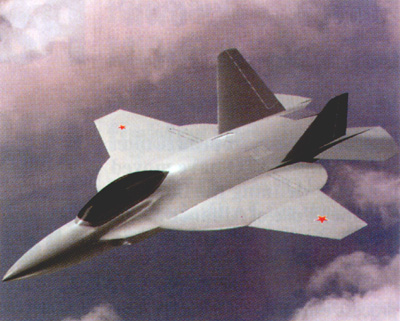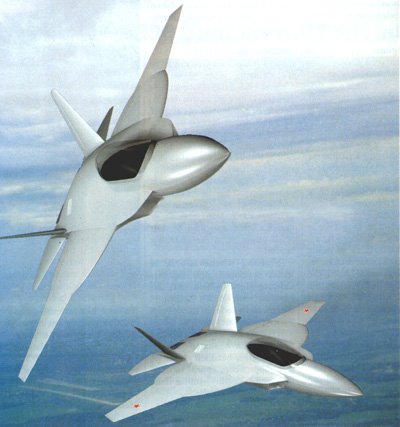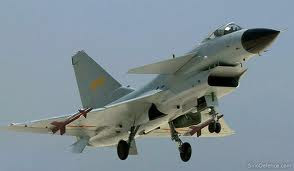While the Russian aircraft manufacturer Sukhoi isflight testing its T-50 PAKFA–the world is watching the tests veryclosely.
Analysts are surprised that China too is testing its 5thgeneration aircraft (which it calls 4th generation). Beijing thinksthat the F-22 is a 4th generation aircraft while the West considers ita 5th generation stealth fighter. With $30 Billion China building J-xx5th generation fighter.
Shenyang J-XX: J-12, J-13, F-XX, J-XX (or J-X or XXJ) is a nameapplied by Western intelligence sources to describe a programme orprogrammes by the People’s Republic of China to develop one or more newfourth- or fifth-generation fighter aircraft. In 2002,Jane’s DefenceWeekly reported that Shenyang Aircraft Corporation had been selected tohead research and development of the new fighter, a claim repeated inNew Scientist the same week. However, a 2006 article in MilitaryTechnology referred to three designs; J-12 & J-14 by ShenyangAircraft Corporation and J-13 by Chengdu Aircraft Corporation.
According to the report from Jane’s, development of the subsystems,including the engine and weapon suite for the next generation fighter,has been under way for some time.
If we ignore the war of nomenclature–the fact remains that Chineseare at par with or possibly ahead of the Russian stealth race.
As for the Chinese 5th generation fighter (or 4th generation as theycall it), it has always been a battle between SAC and CAC. We’vereceived a lot of mixed/contradictory news over the so called J-XX inthe past few years. People first speculated that it will be developedby SAC due to the model they saw in Zhuhai 2002.
By 2007, we started toreceive news that CAC’s design was actually awarded the contract. Atthe same time, many people also certainly speculated that China wasgoing to join this project for the longest time, but that neverhappened. I think that China knew what was at the stake in such acooperation. They would likely get an offer from the Russians for ToTand some development work. Although, the Russians would freeze thedesign according to their needs and keep some of the trade secrets tothemselves.
China Close To Test 5th Gen Fighter–usually tagged as F-XX, but some call it by the moniker J-14.
A Chinese fighter of nominally the same technology generation as theLockheed Martin F-22 will soon enter flight testing, while a jetairlifter larger than the Airbus A400M should be unveiled by year-end.
Beijing’s fighter announcement suggests a serious failing in U.S.intelligence assessments, mocking a July 16 statement of U.S. DefenseSecretary Robert Gates that China would have no fifth-generationfighters by 2020. Industrial competition looks more remote thanstrategic competition, however, since China will want to fill domesticrequirements before offering the aircraft abroad, even if it judgesexport sales to be a wise policy.
The new fighter “is currently under development,” says Gen. HeWeirong, deputy air force chief. “[It] may soon undertake its firstflight, quickly enter flight testing and then quickly equip the forces.
“According to the current situation, [the entry into service] may take another eight to 10 years,” he adds.
No details of the aircraft were given, but it is almost certainlydesigned for supersonic cruise without afterburning. In April, Adm. WuShengli, the navy chief, listed supercruising fighters among equipmentthat his service needed. Notably, all the other equipment on his wishlist looked quite achievable by the end of the next decade, matchingthe timing that the air force now suggests for the fighter.
China classifies aircraft of the F-22’s technology level asfourth-generation fighters, although they are called fifth- generationaircraft in the West. China’s current advanced fighter, the J-10, islocally called a third-generation aircraft, which in Chinese termsmeans that it is comparable with the Lockheed Martin F-16.
Work on “the fourth-generation aircraft is now proceeding intensely,” He says.
Whether the upcoming fighter is really comparable with the F-22remains to be seen. Low radar reflectivity would not be surprising,since aircraft and missiles with stealthy shapes are now popping up inmany countries, including South Korea as recently as last month(AW&ST Oct. 26-Nov. 2, p. 42). But sensor performance, informationfusion and maximum supercruise speed would also be assessed criticallyin measuring a claim to have caught up with technology levels that theU.S. did not deploy until 2005.
The existence of a Chinese fifth-generation fighter, usually taggedJ-XX, has been rumored for years without official confirmation.
If the aircraft does go into service before 2020, then at that timeChina may well have jumped past Britain, France and other WesternEuropean countries in terms of deployed, domestically developedcombat-aircraft technology. That will depend on how quickly thosecountries move to field combat drones to replace current strikeaircraft, says Andrew Brookes of the International Institute forStrategic Studies.
Brookes takes seriously the Chinese objective of technologyequivalent to the F-22, and he sees no reason to doubt that the F-22would be the standard against which they would judge their design. Theknow-how can be imported.
“The Russians have the technology and the Chinese have the money,”he says. “If they really set that as a target, then I think they can doit.”
The aircraft may not bother Western manufacturers in export markets,Brookes suggests, simply because an equivalent of the F-22 would be adestabilizing export that China would be prefer to keep to itself.
Even if China decides that it wants to export the fighter, LockheedMartin should by then be well entrenched with the F-35, which should bemature and reliable at that point. Other manufactures may not be sowell placed, however.
Gen. He made his remarks during an interview on China CentralTelevision as part of the celebrations of the 60th anniversary of theair force of the People’s Republic of China.
China is probably working on two fifth-generation concepts, saysRichard Fisher of the International Assessment and Strategy Center. Oneof those concepts, appearing most commonly in bits and pieces ofevidence that have turned up from time to time, would be a heavytwin-engine fighter probably of about the same size as the F-22. Theother is a single-engine aircraft probably closer to the LockheedMartin F-35.
Gen. He could be referring to either of the aircraft when predictingan entry into service during the next decade. Fisher’s bet is that heis talking about the twin-engine concept.
Like Brookes, Fisher believes China is realistically aiming at theF-22’s technology level. “One has to assume that the People’sLiberation Army is confident in its projections, as it almost nevermakes such comments about future military programs, especially one thathas been as closely held as its next-generation fighter.
“As such, one has to be asking very hard questions: How did the U.S.intelligence community get this one wrong? And inasmuch as no oneexpects the F-35 to replace the F-22 in the air superiority role, is ittime to acknowledge that F-22 production termination is premature andthat a much higher number is needed to sustain deterrence in Asia?”
In his July 16 speech, Gates said that even in 2025 China would have but a handful of fifth-generation aircraft.
The new Chinese fighter could come from the Chengdu or Shenyang plants of Avic Defense.
Gen. He says the Chinese air force plans to emphasize development offour capabilities: reconnaissance and early warning, air strike,strategic supply, and air and missile defense.
The J-10 began large-scale service entry in 2006, state media say.
When Wu raised the prospect of a supercruising fighter, an easyanswer seemed to be an advanced version of the J-10. That looks lesslikely now that He describes the future concept as a full generationahead of the J-10.
“I believe the Chinese have a difficult road if their design is tiedto the J-10,” says a U.S. Air Force officer involved in the developmentof the F-35. “Significantly reduced signature requires more thancoatings. It requires an integrated design philosophy with the rightshaping, the right structure and the right surface coatings.”
Fisher assumes that China is developing improved fourth-generation fighters in parallel with the fifth generation.
The existence of the airlifter has been known for several years, ifonly because pictures of it have appeared fleetingly in presentationsby the Chinese aviation conglomerate Avic.
As expected, it turns out to be a product of Avic’s large-airplanesubsidiary, Avic Aircraft and, more specifically, of the subsidiary’score plant, Xi’an Aircraft.
Avic Aircraft General Manager Hu Xiaofeng says the airlifter is inthe 200-metric-ton class and will be unveiled at the end of this year.
In fact, its design has already unveiled in pictures shown by statemedia. The four-engine aircraft adopts the universal high-wing, T-tailconfiguration. The wing is mounted on top of the circular body, ratherthan passing through a deep segment of it and cutting out much of theusable cross-section. In that respect it is like the A400M, IlyushinIl-76 and Kawasaki C-X but unlike the C-17, whose embedded wingpresents less frontal area.
The main gear of the Chinese aircraft is housed in very protuberant sponsons, like those of the C-17.
A photograph of the cockpit shows five electronic displays ofmoderate size and conventional transport-style control columns. Enginesare not revealed but would presumably be imported from Russia. Awind-tunnel model shows the engines are enclosed in long nacelles, likethose of the Perm PS-90 from Russia.
The PS-90 has a standard maximum thrust of 35,300 lb. in its latestversion. The C-17, with a gross weight of 265 tons, is powered by fourPratt & Whitney F117 engines of 40,400 lb. thrust.
The airlifter’s fuselage appears to be of conventional metalconstruction. The aircraft will be significantly larger than the A400M,which has a 141-metric-ton gross weight.
Hu says it has been independently developed in China. However, hisparent company, Avic, has a long history of cooperation with Ukrainianairlifter specialist Antonov.China Close To Testing Next-Gen Fighter |AVIATION WEEK
So, why did China not cooperate with the Russians. I think Chinarealizes that it has enough aerospace technology base to be able todevelop a true 5th generation fighter. At the same time, the Russianswould always be the primary partner in such a project. It would be hardto imagine China wanting to act second-fiddle and be locked out of alarge part of the development process and some of the advancedtechnologies. By working with the Russians, China would not only pay amajority of the development but also continuously pay Russians forcertain parts of the frame, maintenance/repairs, extra supplies of theengine and maybe even missile/avionics cost. In the end, China hasenough faith in AVIC1 to be able to develop this fighter.
On November 9, General He Weirong, deputy commander of the People’sLiberation Army Air Force (PLAAF), confirmed long-standing speculationsthat the PLAAF is developing fifth-generation fighters(fourth-generation in Chinese standard), which may be in service within8 to 10 years, and certainly by 2020. During an interview withstate-owned China Central Television (CCTV) two days ahead of the 60thanniversary of the PLAAF on November 11, Deputy Commander He announcedthat the next-generation fighter would soon undergo its first flight,closely followed by flight trials (Xinhua News Agency, November 9). Thesenior military officer’s disclosure reflects the considerable progressthat the PLAAF has made in force modernization, which has exceededWestern expectations in terms of the pace of development and thecapabilities of its defense industrial base. While China remainsseveral steps behind the United States in operationalizing its advancedfighter jets, the PLA’s rapid military modernization has raisedconcerns among U.S. allies in the region that the military balance isbeginning to tilt toward China’s favor.
In an interview with Global Times, PLAAF Commander Xu Qiliangstated, “superiority in space and in air would mean, to a certainextent, superiority over the land and the oceans” (Global Times,November 2), thereby highlighting the PLAAF’s position in Chinesemilitary planning. At an event commemorating the PLAAF’s 60thanniversary, President Hu Jintao heralded a “new chapter” in thedevelopment of the PLAAF (Global Times, November 10).
China’s fifth-generation fighters will reportedly have 4Scapabilities: stealth, super cruise, super maneuverability and shorttake-off. According to Air Force Colonel Dai Xu, “its most strikingcharacteristic is the capability of invisibility, which also could becalled low detectability” (Global Times, November 10). The U.S. F-22Raptor serves as the gold standard of fifth-generation fighters, whichis currently the only fifth-generation fighter in service among all theworld’s armed forces. According to General He’s interview, ChengduAircraft, the country’s leading fighter manufacturer, is reportedlydeveloping the fighter with Shenyang Aircraft (Xinhua News Agency,November 9).
General He’s startling revelation that the next-generation fightermay be in service by 2020 stands in stark contrast to the Chinese habitof closely guarding its military capabilities, yet consistent with arecent trend that reflects the Chinese Armed Force’s growing confidencein its military strength. During an interview with the official XinhuaNews Agency back in September, Defense Minister Liang Guanglieproclaimed that, “Our [China’s] capabilities in waging defensive combatunder modern conditions have taken a quantum leap … It could be saidthat China has basically all the kinds of equipment possessed byWestern countries, much of which reaches or approaches advanced worldstandards” (Xinhua News Agency, September 21),.
Indeed, an ongoing survey conducted by Global Times among itsChinese users revealed some telling observations about how theyperceive China’s security environment and PLA airpower. The shortfour-question survey asks the respondents questions ranging from wherethey think the biggest security threat to China in the future will comefrom to how they rate China’s airpower and what type of air forceshould be developed in the future. The first question, which asks howrespondents view China’s security environment, 46 percent of the 9,335who answered said that they think the biggest security threat to Chinacomes from the sea, while 43 percent responded that it is airborne. Thesecond question asked respondents to rate China’s air force, and 50.8percent rated the Chinese Air Force as average, while 44.9 percentrated it as weak. The third question asked respondents what kind ofairforce China should develop, and an overwhelming majority, 75.3percent, responded that China ought to develop a strategic air forcecapable of covering the entire globe. The final question asksrespondents where China should place its emphasis with regard to airforce development, and the majority—47.6 percent—responded that China’sair force should develop a space-based combat unit (satellites, spaceweapons, etc.), while 21.3 percent responded that China’s emphasisshould be placed on developing large airlift platforms (strategicbombers and cargo aircraft, etc.) (Survey.huanqiu.com, November 17).
In light of China’s rapid air force modernization, Japan isincreasingly concerned about Chinese regional air superiority. A KyodoNews report cited by the Global Times quoted Andrei Chang,editor-in-chief of the Canada-based Kanwa Defense Review Monthly, assaying that the PLAAF currently has 280 J-11s, whose combat performanceis comparable to Japan’s Air Self Defense Forces’ 200 F-15s, and 140J-10s, which are a match for the F-16s. According to a Japanesemilitary source, “even though [Japan] has a disadvantage in numbers atthe moment, but combined with its airborne early warning and controlsystem Japan can win in terms of quality.” Yet, the source cautionedthat, “once China deploys its AEWC [KJ-2000, which were on display atthe October 1 National Day Parade] … Japan’s air superiority willgradually diminish” (China Daily, November 11; Global Times, November12).
Recently, we’ve received two pieces of news. The first one is anenthusiastic report on WS-15. The article just got really excited aboutusing digital design for developing WS-15, but it did not reallyexplain how well the project really is doing. According to some onlinesources, the engine should be ready in the middle to later part of nextdecade.
The thrust performance is designed toward matching F-119, butit’s hard to think that WS-15 would be as reliable and stealthy asF-119. We also got one final confirmation from CAC that they got themain design work for the 5th generation fighter. Now, the productionfacility of SAC may still be used to produce a large part of the 5thgeneration fighter, but PLAAF clearly likes CAC’s design better. SACwill be saddled with the design for the naval fighter, future J-11variants and UAV/UCAVs.
CAC now has the upgraded J-10, the 5thgeneration fighter, the global hawk-like UAV and the JF-17 projects towork on. After SAC is done with J-8IIs (hopefully soon), SAC basicallyonly has J-11 variants and UAVs to work on. Also, what does XAC haveafter JH-7A? I presume bomber or fighter-bomber projects, but therereally isn’t a good report verifying much of anything. Also, it’sinteresting that PLAAF selected CAC’s design over SAC despite neitherfirm having built a prototype.
CAC will now be in charge of gettingsome built soon that will use 2 WS-15 engine (or maybe WS-10 series inthe beginning), radar (by probably 14th institute) and integratingdifferent avionics together. CAC is already getting a lot of experiencedeveloping a new generation of avionics on the upgraded J-10. The 5thgeneration plane should take that up a notch to be able to fighter inthe new environment. A new generation of missiles are also beingdeveloped for future fighters. We’ve seen/heard a 5th generation SRAAM,a successor MRAAM to PL-12 and a Metor-like ramjet powered LRAAM. CAChas shown that it can integrate all of this in the J-10 project. So, Ithink PLAAF is making the right decision to pick it ahead of SAC forthe 5th generation design work. At current time, I’ve been reading 2015as the year that this plane will join service. I think this is kind ofoptimistic, because they are not expecting first flight until 2012.
 Development of Russia's LFI (logkiy frontovoi istrebitel) lightweight tactical fighter has been dramatically accelerated after the Russian Air Force decided it's priorities for the next 10 years.
Development of Russia's LFI (logkiy frontovoi istrebitel) lightweight tactical fighter has been dramatically accelerated after the Russian Air Force decided it's priorities for the next 10 years.
 A previously undisclosed, classified stealth helicopter apparently was part of the U.S. task force that killed Osama bin Laden in Pakistan on May 1.
A previously undisclosed, classified stealth helicopter apparently was part of the U.S. task force that killed Osama bin Laden in Pakistan on May 1.


